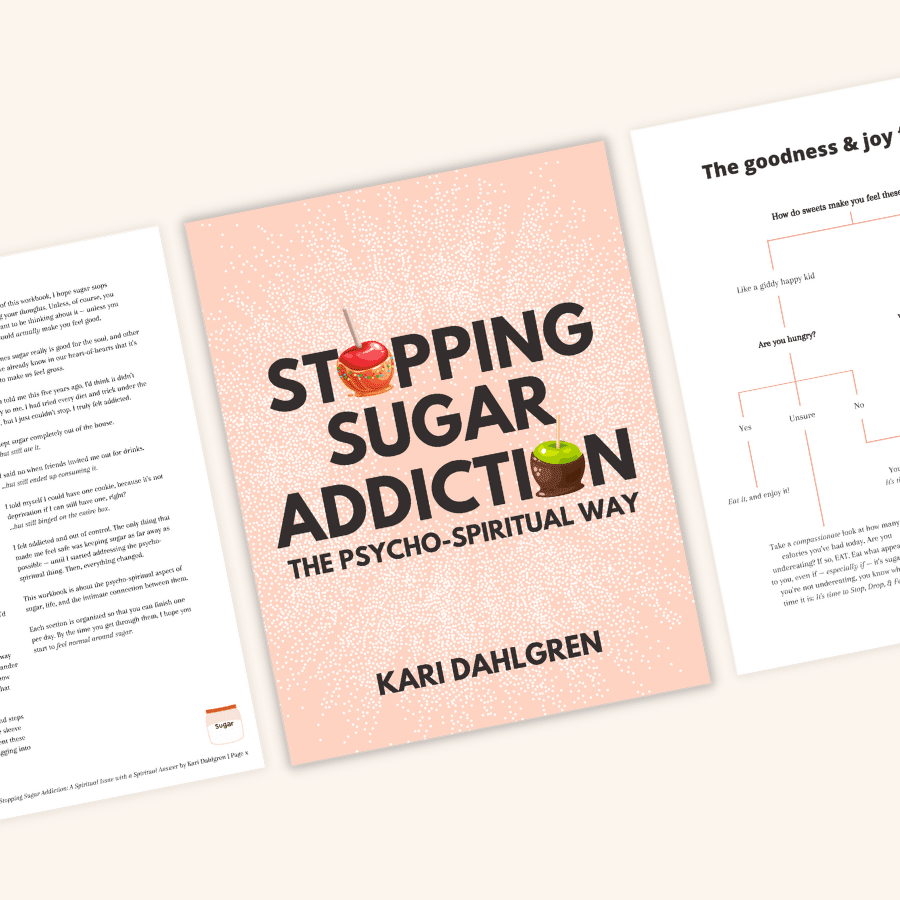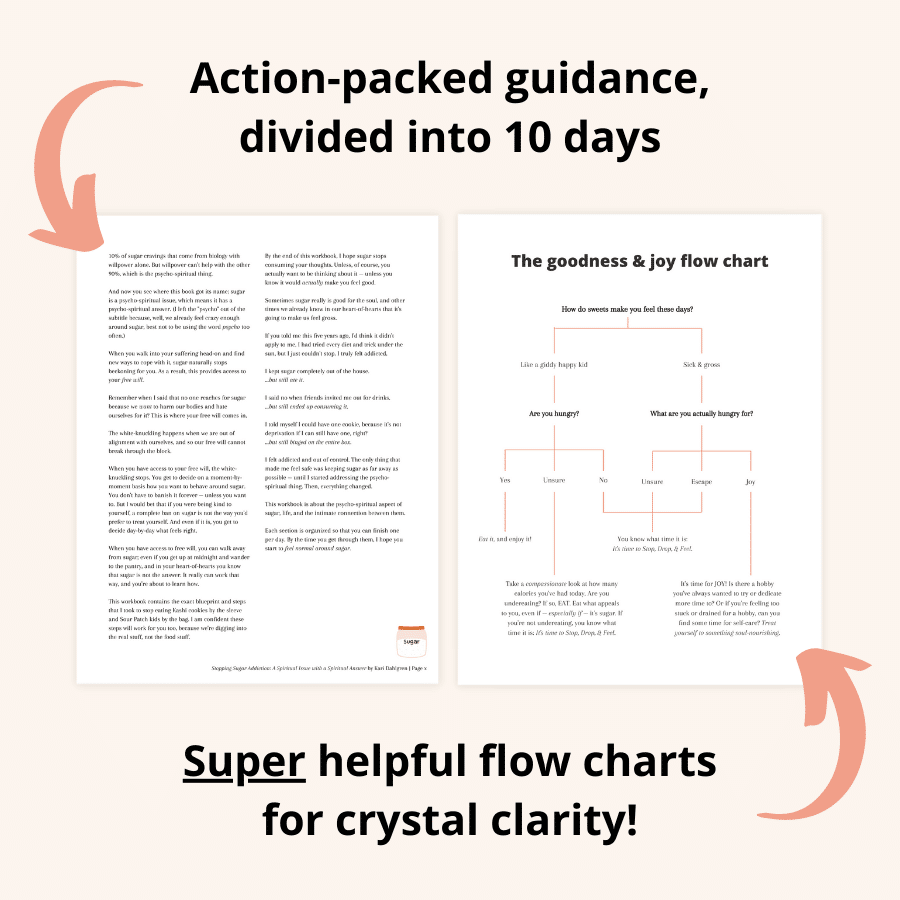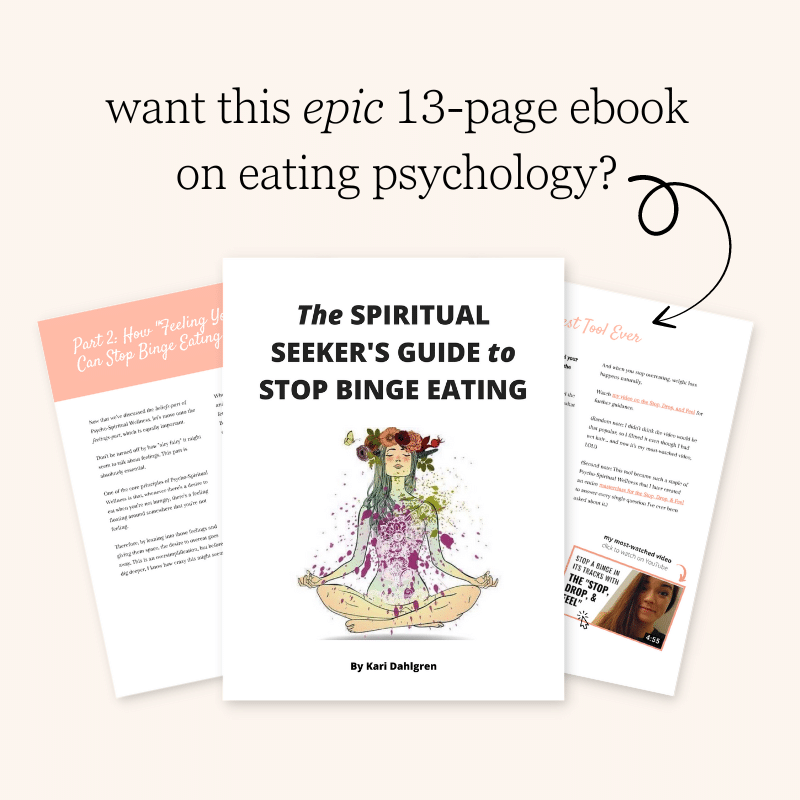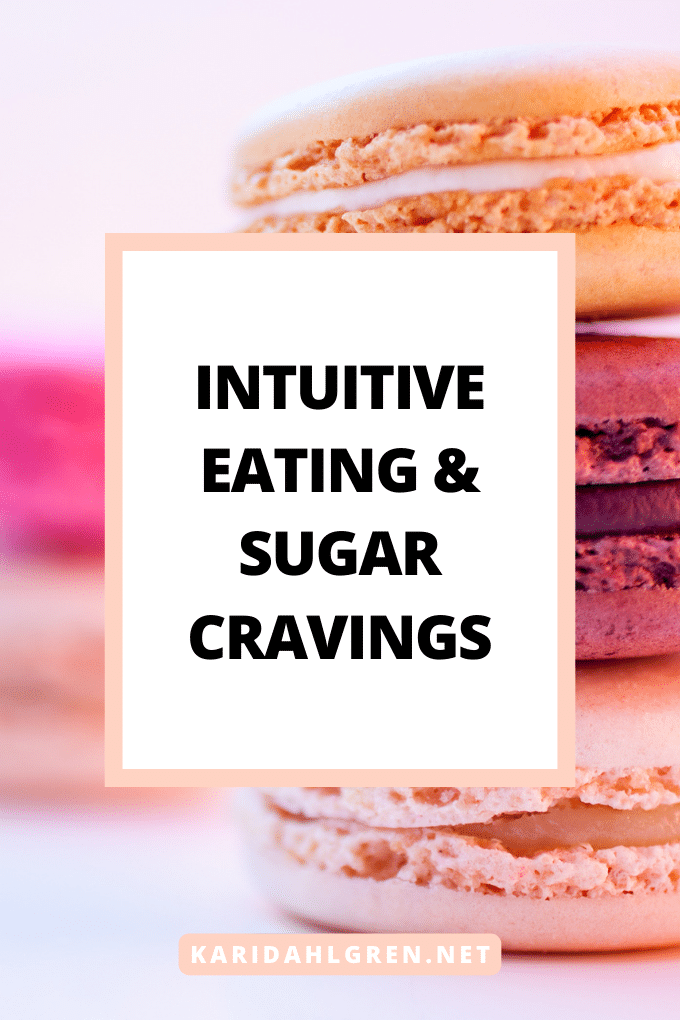
In the realm of dieting, few things feel as haunting as sugar cravings. To use the words of Geneen Roth, a true pioneer of intuitive eating, the “humming and beckoning” of sweets can feel insurmountable, especially when sugar is shadowed by guilt. If you like the idea of intuitive eating but struggle applying it to sugar because you’re afraid, you’re not alone. Navigating intuitive eating and sugar cravings is a complex journey, so let’s walk it together.
As someone who once meticulously counted every gram of sugar and felt the pang of regret every time I binged on sweets, I’ve been there. I’ve known the disappointment of ordering the ‘healthier’ option, only to feel unsatisfied and later binge on sweets anyway. What if there was a way to listen to our bodies and understand our cravings so that we can feel less obsessive around food and more normal around sugar?
By tuning into your body’s cues and embracing intuitive eating, there’s a surprising realization awaiting us all: the very foods we label as “unhealthy” and “bad” (aka, sugar) might just lose their powerful hold over our decisions. Let’s explore how intuitive eating can redefine our relationship with cravings for sweets and guide us towards true food freedom.
Clinical Evidence For and Against “Sugar Addiction”: Is There a Place for Intuitive Eating?
Do you ever feel like your cravings for sugar verge on addiction to sugar? The premise of sugar addiction suggests that our relationship with sugar mirrors the patterns of substance addiction. With the modern shift to diets rich in refined sugars, some researchers draw parallels between sugar consumption and drug addiction behaviors. However, the clinical evidence is mixed.
Those in support of sugar addiction often reference dopamine, a neurotransmitter related to pleasure and reward. Dopamine is released in the brain upon sugar consumption, much like with addictive drugs.[1] In one study, rats overwhelmingly preferred sweetened water over cocaine, indicating the overpowering allure of sweetness.[2]
Another study compared the neural rewards from sugar to addictive drugs and found that sugar might have even more potent neural effects than drugs like cocaine.[3] Furthermore, when given a choice between sweet rewards and drugs, rats leaned towards the sweet option in another study.[4]
However, skeptics question the concept of sugar addiction, citing a lack of clear diagnostic criteria. In a detailed study, researchers emphasized that the evidence for sugar addiction in humans is lacking.[5] They highlighted that the binge eating behaviors observed in rats might be attributed to intermittent access to sugar rather than its intrinsic characteristics.
In other words, restricting sugar not only triggers binge eating behaviors around sugar, but restriction itself could be the cause of so-called sugar addiction, according to clinical evidence.1, 5
If sugar addiction is something you resonate with, then you’ll find relief from the endless restrict-binge cycle in my workbook Stopping Sugar Addiction the Psycho-Spiritual Way. Just like this article, I debunk the myth around sugar addiction (without dismissing it entirely!) while providing a crystal clear map to getting rid of sugar cravings without banishing sugar ever again.
Regardless of where one stands on the sugar addiction debate, the importance of a balanced relationship with food is clear. Intuitive eating, which emphasizes listening to one’s body and its needs, can play a crucial role in navigating sugar cravings and a healthier relationship with food overall.
Hedonic Eating & Sugar Cravings
Sugar addiction aside, there’s another intriguing aspect of eating psychology known as hedonic eating. This describes the act of consuming ‘hyperpalatable foods,’ which includes those high in fat, carbs, or – you guessed it – sugar. Distinctly, hedonic eating is motivated not by physical hunger but purely by the desire for pleasure.
At the core of hedonic eating is the desire to experience the sensory gratifications associated with specific foods, be it the creamy texture of ice cream or the sweet burst from a piece of chocolate. It’s essential to differentiate hedonic hunger from true physical hunger. While the latter arises from our body’s need for energy and sustenance, hedonic hunger is driven by the brain’s reward systems and a longing for the pleasurable sensations that certain foods provide.
In my personal philosophy around stopping compulsive eating, I believe that compulsive eaters already have the capacity to overcome hedonic eating – it’s just a matter of redirecting your focus from your diet to your psychology. While it’s helpful to understand the mechanics of hedonic eating, it’s equally important not to resign yourself as a hedonic eater and that’s it.
Here’s one of my recent YouTube videos where I explain how you can stop overeating when food tastes really good – such as with hedonic eating and sugar cravings:

By understanding the nuances of hedonic eating, we can better recognize the intricate dance between intuitive eating and sugar cravings. Acknowledging that our bodies sometimes desire sugar for pleasure rather than sustenance can offer a compassionate lens through which we view our eating behaviors.
Instead of berating ourselves for every sugary indulgence, we can introspect, asking if it’s a hedonic desire or a true need. This self-awareness paves the way for a balanced relationship with sugar, aligning more with the principles of intuitive eating.
Understanding Intuitive Eating and Sugar Cravings
Intuitive eating is a holistic approach to nourishing yourself. It transcends traditional dieting methods that often categorize foods into binary realms of “good” and “bad.” A cornerstone of intuitive eating is the act of consuming foods based on genuine hunger cues, as opposed to emotional or external triggers.
Intuitive eating encourages you to tune into your innate hunger and satiety signals so that food becomes a source of nourishment rather than an emotional crutch.
Intuitive eating takes a stand against labeling any food as strictly “good” or “bad,” including sugar. Instead, all foods are neutralized and seen as potential sources of nourishment, enjoyment, or both. This perspective fosters a more harmonious relationship with food, devoid of unnecessary guilt or shame after eating.
When it comes to sugar consumption, the principles of intuitive eating hold immense relevance. Given that sugar has been demonized in many dieting circles, many of us carry a burden of guilt when consuming foods that are sweet or high in sugar. This guilt can lead to the vicious restrict-binge cycle where sugar is limited and, because it becomes a forbidden food, is later binged on.
When adopting intuitive eating, sugar is just another food, devoid of moral implications. Instead of viewing a sugary treat as a “guilty pleasure” or a “cheat meal” (a potential sign of entitlement eating), it’s seen for what it truly is – a source of pleasure, energy, or perhaps even comfort.
Intuitive eating encourages you to determine whether the desire for sugar stems from a physiological need, a hedonic craving for pleasure, or perhaps a mix of both. This discernment is an important step in making peace with sugar. Though, it is not the only step, as you will soon see.
With intuitive eating, sugar is no longer a forbidden fruit – but rather a choice.
Sometimes the body may genuinely crave the quick energy sugar provides, such as after a good workout or after going too long without eating. Other times, one might want to savor a dessert purely for the joy of it. In this light, intuitive eating makes hedonic eating normal!
Also, eating intuitively – including sugar – won’t make you unhealthy. Studies have found that people who eat intuitively tend to eat a more varied diet than those who don’t.[6] Researchers found that the more intuitively someone eats, the more pleasure they experience in eating and the less anxiety they feel around food.
By approaching sugar consumption with an intuitive lens, one can indulge mindfully, savoring every bite, while also recognizing when they’ve had enough. It sounds great in theory, but it can be difficult to practice, especially if you have a long history of dieting. Up next, I’ll share some excellent tips to help you put all of this into practice.
Managing Sugar Cravings with an Intuitive Approach

Intuitive eating presents an opportunity to free yourself from the cycle of depriving yourself of sweets and inevitable binge eating sugar. Rather than viewing sugar as an enemy to be vanquished with sheer white-knuckling willpower, intuitive eating empowers you to find holistic health by tuning into your body’s signals.
Here are excellent steps that you can take to adopt intuitive eating while focusing on sugar cravings:
Step 1: Determine If Your Sugar Craving Is Physical or Emotional Hunger
With intuitive eating, the balance between understanding physical and emotional hunger is fundamental, especially when managing sugar cravings. When physical hunger knocks, it’s essential to honor what your body is asking for.
If that happens to be sugar, it's perfectly okay to indulge.
Denying genuine cravings for sugar and forcing oneself to consume something labeled as ‘healthy’ or ‘good’ can backfire. Often, this leads to overindulging in sugary treats later, resulting in a higher overall intake than if the initial craving was simply honored.
I’ve been there before, forcing myself to settle for a bowl of pretzels instead of chocolate. Then eating veggies and hummus instead of chocolate… Later eating last night’s leftovers instead of chocolate… And finally eating an entire sleeve of chocolate cookies because nothing I ate up until then hit the spot!
Satisfaction in eating is important, and it works much better to just eat the satisfying thing when you’re craving it. Many dieters (and non-dieters) are terrified of eating sugar because there’s evidence that too much of it is “bad” for us. The key words here are “too much.”
Furthermore, I’d like to speculate that eating a handful of sugar when you’re craving it is much better than compulsively eating a greater quantity of sugar because you’ve made it off-limits. Permission to eat goes a long way.
Step 2: Use the Stop, Drop, & Feel to Diminish Sugar Cravings from Emotional Hunger
I’ve made it my life’s work to discover and document all the psycho-spiritual nuances between our psychology and our relationship with food. From both my personal climb out of compulsive eating and many years coaching others through it, I’ve found that emotional eating, especially where sugar is concerned, is a byproduct of suppressing uncomfortable feelings. This is where my Stop, Drop, & Feel method becomes an invaluable tool.
At its heart, the Stop, Drop, & Feel is about building emotional awareness and emotional tolerance, or the ability to feel uncomfortable without getting swept into compulsion. It’s rooted in the belief that behind every urge to eat without hunger, there’s an edgy emotion that we might be ignoring or avoiding.
Here’s a video that explains how the Stop, Drop, & Feel works:
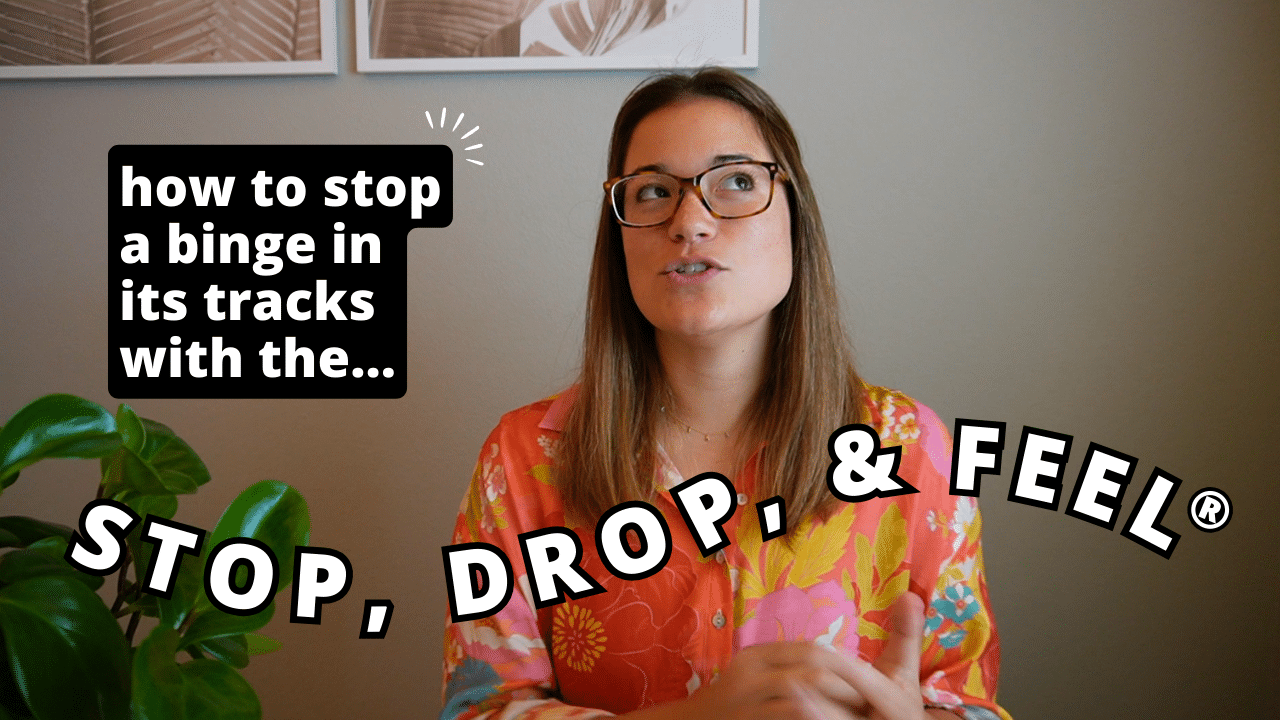
- Stop: Before you reach for sugar when you aren’t hungry, pause and promise yourself that you have 100% permission to get back to the sugar if that’s still what you really want, but first you’re going to Stop, Drop, & Feel.
- Drop: Go to another room (away from the sweets) and drop into your feelings. Get curious about your emotional state. If you’re anything like me, an uncomfortable emotion will bubble up – perhaps one you weren’t even aware of!
- Feel: Make space for the edgy emotions to coexist with you. Don’t resist them, as resisting emotion only makes them stronger. Instead, surrender as best you can and trust that you’re working on a productive skill: emotional tolerance.
Sugar often serves as an emotional balm, providing relief from stress, sadness, boredom, etc. By practicing the Stop, Drop, & Feel method, we train in facing these emotions head-on, rather than burying them with a sugar rush. Over time, as we develop emotional tolerance, the instinct to reach for sugar in response to emotional eating diminishes.
Furthermore, the Stop, Drop, & Feel method underscores the importance of permission. By not labeling sugar as forbidden, we remove its allure as a ‘guilty pleasure.’ This reframing changes our relationship with sugar entirely, aligning it more closely with intuitive eating.
Step 3: Eat Enough Food to Decrease Sugar Cravings from Physical Hunger
Eating enough is crucial for managing sugar cravings. Studies have found that when we restrict our food intake, our body’s “hunger hormone,” ghrelin, increases, leading to powerful cravings for high-calorie, often hedonic, foods.[7] This response is our body’s way of ensuring survival during perceived food scarcity. Ironically, the more we limit our food, the stronger these hyperpalatable (i.e. sugary) cravings become, trapping us in a cycle of restriction and overeating.
Furthermore, while the Stop, Drop, & Feel method is a robust tool for addressing emotional eating, it doesn’t work if you’re physically hungry. When you eat enough food, not only do you decrease the frequency of sugar cravings, but you also heal your metabolism from the damage inflicted by dieting, and gain clarity around physical vs. emotional hunger.
If you’ve eaten enough food and you’re craving sugar, it’s time to do the Stop, Drop, & Feel. But if you haven’t actually eaten that much on a day when your sugar cravings are strong, it could be your body’s way of asking for fuel (physical hunger).
Intuitive Eating, Sugar, and Diabetes
Now that you’re equipped with a robust toolbox full of resources to navigate physical and emotional cravings for sugar, what can you do if you have a medical condition that limits how much sugar you can eat such as diabetes?
This doesn’t mean intuitive eating isn’t an option; it just means you need to adapt it with a focus on individual health needs.
- Collaborate with Healthcare Professionals: Most importantly, if you have diabetes, it’s imperative to work closely with your healthcare provider. They can offer guidance tailored to your specific needs, ensuring you’re balancing intuitive eating principles with essential blood sugar management. Intuitive eating can coexist with health constraints, but it requires a tailored approach.
- Challenges and Misconceptions: A common misconception is that diabetics must avoid sugar entirely. While it’s true that sugar intake must be monitored, it’s not the only dietary factor affecting blood sugar. Other carbs, the timing of meals, and even protein and fat intake can play roles.
- Adapting Intuitive Eating: Intuitive eating for diabetics might seem counterintuitive due to the need to monitor carbohydrate intake, but it’s still possible. It involves understanding body cues related to blood sugar fluctuations and making food choices accordingly.
Remember, intuitive eating isn’t about eating anything and everything without consideration; it’s about listening to and respecting what the body needs. For someone with diabetes, this might mean acknowledging a sugar craving but opting for a small, satisfying amount that won’t severely impact blood sugar levels. When “just opting for a small amount” isn’t accessible (after all, that’s the very nature of compulsive eating) the Stop, Drop, & Feel becomes even more important.
In all situations, but especially if dealing with health conditions like diabetes, it’s crucial to consult with a healthcare professional when considering changes to your dietary habits.
Finding Intuitive Eating and Unwinding Sugar Cravings
Listening to our bodies to inform what and when we eat (aka, intuitive eating) can help us reshape our relationship with sugar cravings and food. It enables us to distinguish between genuine hunger and emotional triggers while making balanced choices. By approaching sugar as a neutral part of our diet, we can find satisfaction without guilt.
Keep in mind that my philosophy for stopping compulsive eating, Psycho-Spiritual Wellness, is distinctly different from intuitive eating. To learn more about Psycho-Spiritual Wellness, download my free ebook below and join my exceptionally helpful newsletter:

